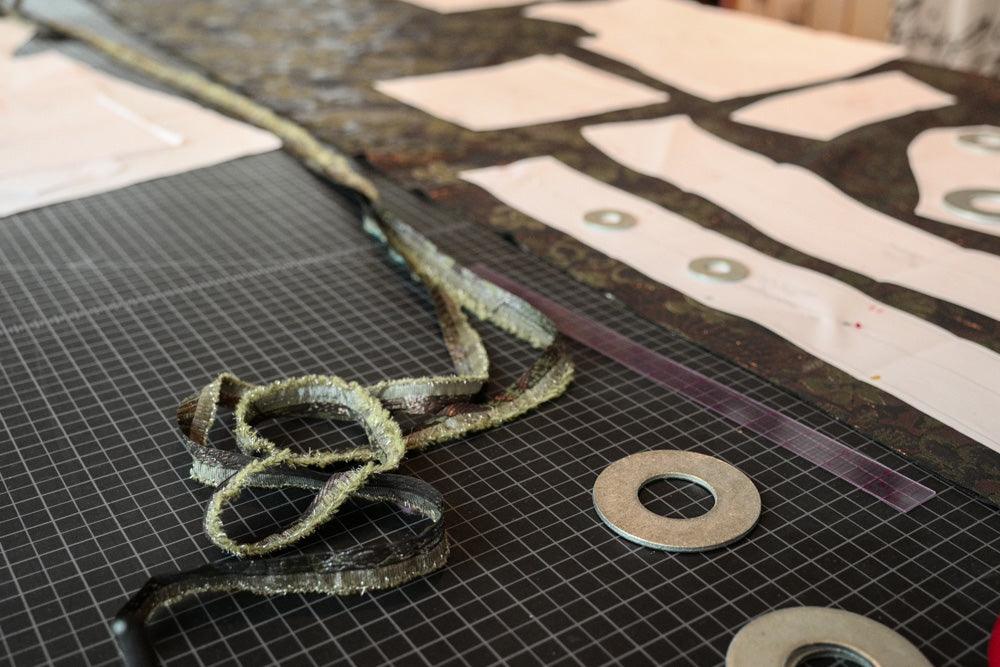Both of us tested the design for ourselves before our get-together, and there are two other experienced who also tested the pattern. Jean Bailey is a technical writer who adds her expertise to the instructions and makes beautiful renditions. Nancy Murakami has an eclectic style that adds an practical fun perspective. We all work with only the pattern pieces as they come from the professional pattern maker, no instructions, no seam allowances and minimal markings. We e-mail back and forth, send photos and comments. On this project, I made 4 different experimental versions. Gwen brought her version along and before deciding on fabric and cutting out the samples, we have deep discussions about things like understitching, interfacing and the ideal finished width on a sleeve cuff. During our working sessions, we each cut and make one version. I write the instructions and Gwen edits. In this case, I'd written instructions for the tricky bits, so we printed them off and Gwen followed them in her sewing. She is a pro, works much faster than I do....but it is not a race, and we go back and forth about deciding the best way to do things.
The final instructions will go off to Jean who edits and adds a note of final polish.
Dubbed the 'Shacket' because it can work as either a shirt or a jacket, we auditioned a number of fabrics before landing on the final choices. We decided on a brocade I'd been saving for this project, and chose a linen from a new collection of Japanese fabrics that had just been photographed, (not posted, coming soon). Gwen sewed the brocade version. I worked with the Japanese linen in a print that required careful cutting and matching. This took more fabric to get the placement right, and I was glad to have plenty on hand as I re-cut the collar and cuff to get just the right look.
I often get questions about how much fabric to buy, and notice that many sewists are scrupulous about getting exactly what the pattern states, or fall into a tizz if the width for their fabric is not listed on the pattern envelope. See more musings and opinions in the blog, Most Asked Questions About Fabrics.
Under stitching, yes or no? Interfacing? Seriously, we think about the rules, and bend them to our will.
Trimmed Selvedge
Jacket Design Tips from Marcy
Each jacket I make is one of a kind, and my favorite way to sew is to start with some aspect I love. Inspiration? Sometimes it is the fabric, sometimes it is the pattern or a detail or a color or a need in my wardrobe. Could be as basic as needing a raincoat or because I’ve just bought (or designed) a new pattern.Regardless of what inspired you, before you cut, consider these design options:
- Use more than one fabric.
- Add a seam at center back.
- Add a seam to the sleeve: at center,or divide the seam in 1/3, placing the seam at the
- back 1/3.
- Change the width or design of a sleeve at the hem.
- Add a cuff or facing to the sleeve.
- Change the shape of the edge.
- Make the front and back different lengths.
- Make your own fabric by piecing or using surface design.
- Combine different fabrics.
- Use selvedges.
- Use raw edges.
- Use topstitching.
- Use hand stitching or embroidery.
- Cut the pattern pieces up, add allowances and stitch them back together again.
- Incorporate sheers.
- Add piping, inserts of other fabric in the seams.
A Sewing Favor For Yourself, thanks to Gwen!
Gwen's Cashmere and Silk Throw
It was a cold, snow-y, sleety weekend. At the end of the day, we cook together, hang out by the fire and watch a British mystery. Gwen brought her current hand sewing project, a throw made from recycled overdyed cashmere sweaters hand sewn together, then 'quilted' to a silk jacquard backing. Gwen uses a curved needle inherited from her grandmother to do the hand sewing. To finish, she'll trim the silk along the edges, then bind with the same silk.






